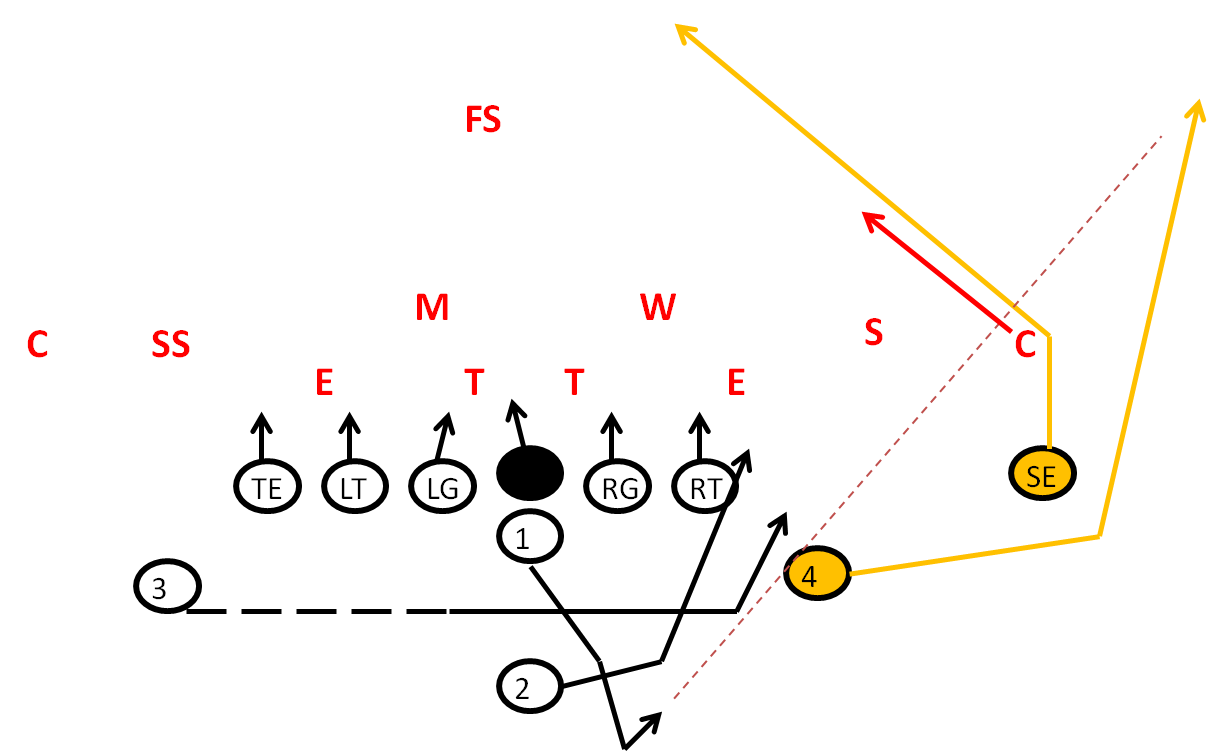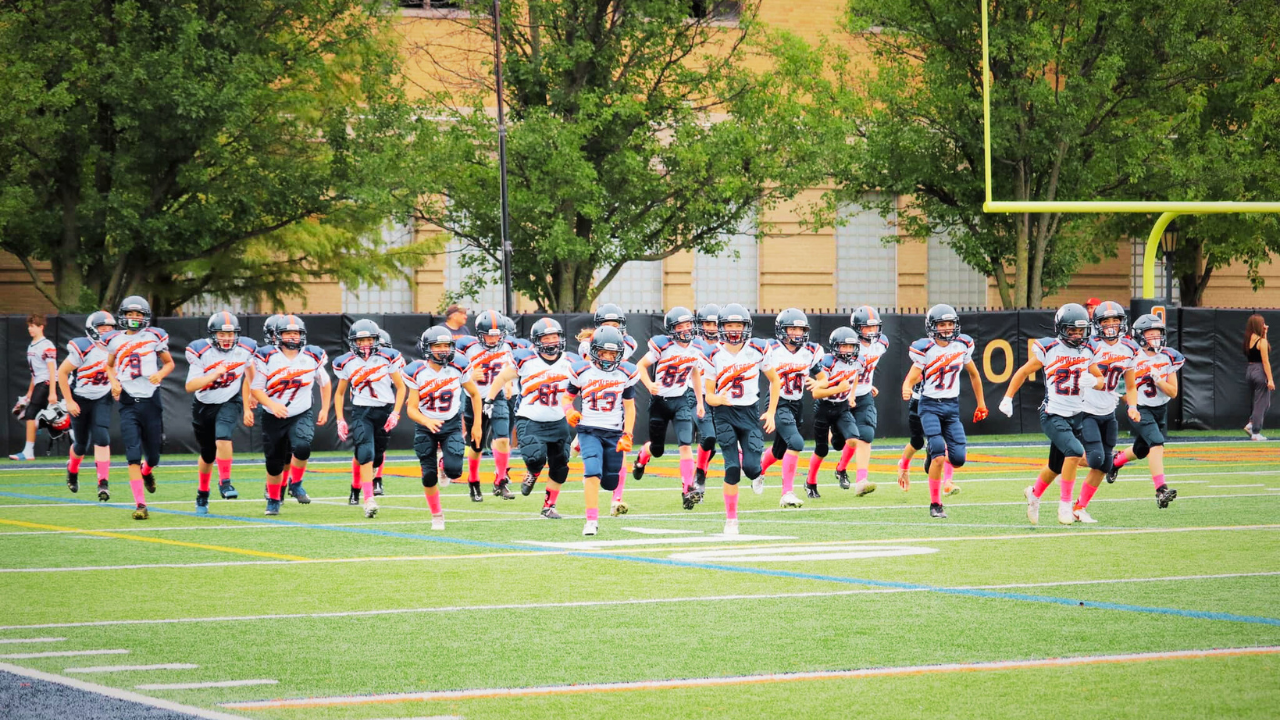Toast the Defense with the Post Wheel Passing Concept

We love to beat the defense with the post wheel passing concept. This post wheel play features the split-end (SE) running a post pattern and either a running back, slot, or wing-back running a wheel route. The post wheel passing concept works very well against both man to man coverage and zone coverage. Even zone defenses will tend to lose track of the wheel route player. The only real concern with this play is that it can take some time to develop. The offensive line has to hold up. I have been running post/wheel for as long as I can remember. This play has been the most successful for us off of play-action. Play-action will buy the offense time and allow for easier pass blocking. Easier pass blocking because the defense will bite on run, not immediately focused on rushing the QB. As long as the throw and catch is good, this is at least one guaranteed touchdown or big yardage play for us. Below are three play diagrams of our favorite ways to execute the post wheel passing concept.
Post Wheel Passing Concept off Jet & Belly
This post wheel passing concept is off of our jet sweep play. We’ve had the most success running the post wheel out of the above Wing T formation. This play actually fakes our jet sweep and our belly play. The defense will come flying up to defend jet & belly. The wing-back (4), sneaks out on the wheel route. Regardless if it is zone or man coverage, the defense almost always loses track of the wheel route player.
Center: Pass block- step into block.
Right Guard: Pass block- step into block.
Right Tackle: Pass block- step into block.
Left Guard: Pass block- step into block.
Left Tackle: Pass block- step into block.
Tight-end (TE): Pass block- step into block.
Split-end (SE): Post pattern at the middle safety. The (SE) needs to run his post pattern at full speed. The split-end must keep the safety in the middle of the field, while clearing out the cornerback.
QB (1): Fake jet sweep and belly, drop back, set, and throw to the wheel route. Football must be thrown outside and right to the wheel player. No floating passes.
Fullback (2): Fake belly, block edge.
Right Wing (4): Wheel route. The wheel route needs to be execute wide- wheel away from the defense.
Left Wing (3): Fake jet sweep and block defensive end. Motion player cannot go or lean forward until the football is snapped.
Post Wheel Passing Concept to Jet Motion
If you notice the defense is not running with the jet motion player you can throw him the football. We run jet motion on a regular basis throughout a game. We watch to see how the defense is playing our motion. We will see man to man coverage 9 out of 10 games. Defenses usually do not even run with or keep up with our motion player. When they don’t run with or keep up, we will throw our motion player the football. You can also just have the motion player run into the flat if you are concerned about pass protection. As long as the (SE) is able to clear out the CB the motion play will be wide open.
Center: Inside-over- pass blocking rules.
Right Guard: Inside-over- pass blocking rules.
Right Tackle: Inside-over- pass blocking rules.
Left Guard: Inside-over- pass blocking rules.
Left Tackle: Inside-over- pass blocking rules.
Tight-end (TE): Inside-over- pass blocking rules.
Split-end (SE): Post pattern at the middle safety. Clear out the cornerback.
QB (1): Fake belly, drop back throw the wheel route. The football should be snapped when the motion player is at the play-side tackle.
Fullback (2): Fake belly, block.
Right Wing (4): Block Edge defender (E).
Left Wing (3): Full speed motion, when ball is snapped run wheel route away from the defense. Motion player cannot go or lean forward until the football is snapped.
(See Also) Shotgun Wing T Playbook
Post Wheel Concept out of the Pistol- Twins Formation
This post wheel is draw up out of the pistol twins formation. I love the post wheel out of the pistol twins formation because it has a flood passing concept component. This flood concept works very well against zone coverage. The (H) running a swing pattern really puts that (S) and outside backer (W) in conflict. If you want to beat zone coverage flood one side of the field.
Center: Pass block- step into block.
Right Guard: Pass block- step into block.
Right Tackle: Pass block- step into block.
Left Guard: Pass block- step into block.
Left Tackle: Pass block- step into block.
Tight-end (Y): Pass block- step into block.
QB (1): Fake tot he tailback (T), drop back 3 steps, throw the wheel route.
Split-end (X): Post pattern. The (SE) must run his post pattern right at the middle safety.
(H) back: Swing pass out wide. The (H) must continue his route outside to thin out the coverage.
Slot Receiver (S): Wheel route out wide, away from the defense. The (S) aiming point for the wheel is the the back heels of the (X).
Tailback (T): Fake power to the right, pass block defensive end or edge defender. The (T) must attack this block, don’t wait for the defender to come into the backfield.
Coaching Points
- Best executed off of play-action. It gives the offense more time. It makes the defense bite up for run.
- The wheel pattern needs to wheel wide, away from the middle safety.
- Best executed to the wide side of the field.
- QB needs to get depth and plant and throw.
- Wheel pattern player must get outside before wheel his route. As soon as the ball is snapped, the wheel player has to run his wheel route at full speed!
- Split-end (SE) or (X) need to run a post pattern right at the middle safety. You can also have him sell it by putting his hand up like he wants the ball.
- If they don’t run with the post or there is no middle safety you can throw to him. He is definitely a passing option.
(See Also) Wide Receiver Route Running and Stance
(See Also) Flood Passing Concepts












